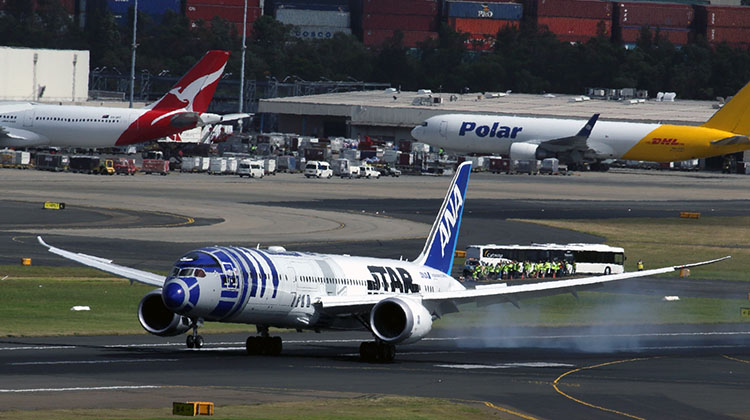
Australia’s Department of Infrastructure, Transport, Cities and Regional Development has dismissed concerns Virgin Australia may not be in a position to commence nonstop flights to Tokyo Haneda by March 2020.
Virgin Australia has applied to Australia’s International Air Services Commission (IASC) for one of the two available slots for flights between Australia and Tokyo Haneda.
Should the request be approved, Virgin Australia planned to commence nonstop flights between Brisbane and Tokyo Haneda from the end of March 2020 with Airbus A330-200s featuring 20 business class seats with direct aisle access for every passenger and 255 economy class seats at eight abreast.
The new route would also be flown in partnership with Japan’s All Nippon Airways (ANA).
Meanwhile, Qantas has applied for both available slots to add a second daily Sydney-Tokyo Haneda service and switch its current Melbourne-Tokyo Narita flight to Haneda.
In its submissions to the IASC, which manages Australia’s international traffic rights, Qantas said it was the “only no risk option” to meet the requirement for the two Tokyo Haneda slots to be utilised from March 29 2020.
Further, the Flying Kangaroo questioned whether Virgin Australia would be ready to begin flights to Japan by the end of March 2020.
Virgin Australia has brushed off those concerns, describing them as “mere conjecture”. The airline said it was well placed to begin flights between Brisbane and Tokyo Haneda by March 29 2020.
And a letter to the IASC written by Stephen Borthwick from the Department of Infrastructure, Transport, Cities and Regional Development’s aviation industry policy unit has expressed confidence in Virgin Australia International Airlines (VAIA) being able to utilise the available capacity.
“Based on current information, the department considers VAIA is reasonably capable of obtaining the relevant licences, permits and other approvals required to operate on and service the Australia-Tokyo (Haneda) route and using the capacity that VAIA has sought in its application,” Borthwick said in the letter dated October 9 and posted on the IASC website.
The letter stated the IASC had written to the department on September 24 regarding Virgin Australia’s application.
Separately, on October 8, the IASC wrote to the department seeking further information on what would happen with unutilised Tokyo Haneda slots.
Borthwick said in response to that letter it was the department’s view that “in the event an Australian airline was allocated a slot to/from Haneda Airport and was subsequently unable to establish or sustain operations using that allocation, the unutilised slot would then be able to be allocated to another Australian airline”.
“However, this would ultimately be a decision for the Japanese authorities,” Borthwick said.
In September, the Japanese Ministry of Land, Infrastructure, Transport and Tourism (MLIT) allocated a total of four new slot pairs for Australia-Tokyo Haneda routes, comprising two new slot pairs for Japanese carriers – one for All Nippon Airways (ANA) and one for Japan Airlines – and two new slot pairs for Australian carriers.
The allocation was among a package of 50 slot pairs for international services at Tokyo Haneda, with 25 for Japanese airlines and 25 for international carriers.
Also, the slots would be for daytime services – notionally between 0600 and 2255 – as air traffic managers opened up more airspace in the Tokyo area to support the additional flights.
Virgin Australia’s application for one of the two available slots has been supported by the Australian Competition and Consumer Commission (ACCC), Brisbane Airport and Tourism Australia.
Similarly, the Victorian government has backed Qantas’s application to use one the two available slots to switch its Melbourne-Tokyo Narita service to Haneda.
Tokyo Haneda Airport, which is located much closer to Tokyo city than Tokyo Narita, had previously been predominantly used by Japanese carriers as a domestic airport.
However, there have been efforts to expand the number of international services at Haneda amid a Japanese government push to attract more tourists to the country.

Currently, there were nine nonstop routes between Australia and Japan operated by four carriers – Sydney-Tokyo Haneda (ANA and Qantas), Sydney-Tokyo Narita (Japan Airlines), Sydney-Osaka Kansai (Qantas), Melbourne-Tokyo Narita (Japan Airlines and Qantas), Brisbane-Tokyo Narita (Qantas), Gold Coast-Tokyo Narita (Jetstar), Cairns-Osaka Kansai (Jetstar), Cairns-Tokyo Narita (Jetstar) and the recently commenced Perth-Tokyo Narita service from ANA.
And there is new capacity coming later in 2019, with Qantas scheduled to operate a seasonal Sydney-Sapporo nonstop flight with Airbus A330 equipment between December 2019 and March 2020.

The IASC said on September 3 it was aiming to allocate the two Tokyo Haneda slots by October 31 2019, in order to enable Australian carriers to begin flights from March 29 2020, the start of the 2020 northern summer scheduling period. It described the deadline as a “tight timeframe”.
ANA and Japan Airlines were yet to announce how they planned to use the additional Tokyo Haneda slot for Australian routes.










